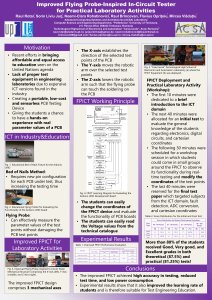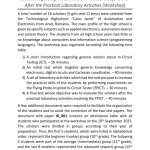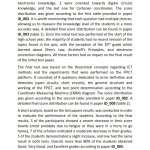Today, the most affordable conference for Ph.D. students I know kicked off in Romania, namely SIITME 2023. I have the pleasure of announcing that a research paper I am a co-author on will be presented Thursday by my former colleague from Politehnica University Timisoara, Raul Rotar, and that this research paper will be published later in the IEEE Xplore Digital Library and Clarivate ISI Web of Science Core collection database. The research paper is titled „Improved Flying Probe-Inspired In-Circuit Tester for Practical Laboratory Activities“ and is based on a research paper titled „Affordable Flying Probe-Inspired In-Circuit Tester for Printed Circuit Boards Evaluation with Application in Test Engineering Education“ on which I am the lead author and which I published in 2020, just a few months before completing my Ph.D. studies.
In the present work titled „Improved Flying Probe-Inspired In-Circuit Tester for Practical Laboratory Activities„, the existing FPICT was improved and also tested in a real high school practice laboratory by Raul (he plans to finish his Ph.D. studies in the coming months, maybe Spring 2024, Tesla sei Dank… :)) ), together with some other co-authors to demonstrate the effectiveness of our FPICT in increasing the learning curve of young students in test engineering education. I am discussing with Raul actively if we should apply for a patent regarding this device or not, because I am usually against patents, and support open source of any nature. I would like to see this device being mass-produced and available in all test engineering education laboratories around the world as soon as possible.
Abstract: This paper presents an innovative, improved, and sensorless Flying Probe-Inspired In-Circuit Tester (FPICT) for verifying the interconnects of Printed Circuit Boards (PCBs). The proposed tester, due to its portability, can be easily deployed in laboratory environments for practical purposes. Thus, our research aims to demonstrate the effectiveness of the FPICT in increasing the learning rate of young scholars in Test Engineering Education (TEE). A total number of 16 high school students from „Caius Iacob“ Technological High School of Electronics and Automation of Arad, Romania, were selected as the target group for the test platform studies. Before the practical laboratory activities, we performed a series of tests to evaluate the reliability of the improved FPICT. The experimental results show that the proposed FPICT is suitable for smaller and medium-sized PCBs and proves efficient regarding the probe’s positioning accuracy (99.06% for measurement testing), navigation time (an average of 8.20 seconds for single point testing), power consumption (an overall of 14.67W for all considered test cases), and cost (around 30 dollars). The obtained results indicate that the FPICT prototype passed the initial tests and can now be utilized in a learning environment for the final product validation stage.
You can read our research paper „Improved Flying Probe-Inspired In-Circuit Tester for Practical Laboratory Activities“ here: https://ieeexplore.ieee.org/document/10430652.

Regarding the experimental results done with the high school students from „Caius Iacob“ National College of Arad, Romania, I present below the original files with the grades obtained by each group of students in the 2 tests (the duration of the tests was 40 min for the theoretical test and 1h for the practical test). Originally, 17 students were invited to our Workshop, but one could not attend due to medical reasons, this being the reason we tested the theoretical and practical knowledge only of 16 persons (5 girls and 11 boys).
Due to the General Data Protection Regulation (GDPR), I am not allowed to share the full names and pictures of the students while having fun practicing with our improved FPICT in the laboratory.
In conclusion, we are very happy to see our low-cost FPICT device being loved by young students (aged between 15 and 19 years old), with many of them smiling and asking various questions while practicing with it. The workshop proved to be successful, demonstrating that our improved FPICT device is a promising tool for improving the learning rate of young high school students in test engineering education. Ideally, it would have been even better to have around 100 high school students present in the laboratory for evaluation. However, for this, we would have faced several challenges because this would have required experiments during a couple of weeks, we would have needed to create many subgroups, receive permission to block the laboratory several hours during a couple of weeks, make sure that such a big amount of high school students can attend and be present during our evaluation, etc.), this being the only minus point we see in our article if we can call it like that.
As I mentioned earlier, we would be more than happy to mass produce it and see it available in all laboratories around the world. But until that happens, we plan to make it accessible online through a friendly online GUI (Spoiler Alert: with the help of a custom robotic arm, test engineering students will be able to pick from a variety of PCBs and test them with our FPICT, watch everything in real-time through a webcam stream, etc.), but more about this in a future blog post, hopefully, next summer, if we can finish writing the research paper about it as well by then. 😉



Neueste Kommentare